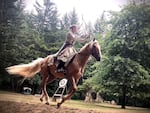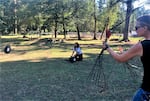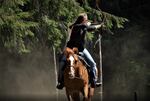Beesh Lotspeich leans forward to her horse’s ear and growls, “Let’s kill it!” She spurs the horse. It breaks into a canter with a burst of raw power.
As they pass between two wooden poles, they trigger a timer. The seconds are now clicking away.
She feels the sides of the horse’s ribs expand and contract with each breath. She reminds herself not to tense up but to breathe.
Beesh feels the pounding of the hooves as they hit the dirt track. The hooves thump in a three-beat cadence with each stride, thud-a-lump. Her body rises up with the horse, and falls back to the earth, thud-a-lump. She and the horse are now perfectly in sync.
She drops the reins. She is now trusting the horse completely.
She sees the target ahead. She lifts her bow. Curling her thumb and two fingers around the bowstring and the notch of her arrow, she draws.
For a split second, the horse hits the top of its gait, sometimes called a “moment of suspension.” All four feet are in mid-air. And in this instant, both horse and rider are floating above the ground.
Release.
As soon as the arrow leaves her hand, Beesh knows whether it will hit or not.
The arrow penetrates the target with a reverberating thwap.
“It vibrates through my whole body,” Beesh says.
“When you’re on, and that horse is on, and everything is just meshing, it is just such a wonderful feeling to just feel all that power going,” she says “That’s my thing.”
Beesh is a horse archer. It’s an ancient martial art from bygone battlefields, taken up by a modern generation as a recreational sport. For this weekend, Beesh has traveled from her home in southern Oregon to northern Washington for an official competition of the World Federation of Equestrian Archery.
For Beesh and many of the other participants, this weekend is about more than scoring points and rankings; it is also about tapping into something primitive and personal, working in a partnership with their horses, and finding a strength inside themselves that they are learning to bring out as their full power.
Discovering horse archery
Beesh was in her late 20s and working at Starbucks when a flier on the bulletin board caught her attention. It announced that there would be a demonstration of horse archery at the local fair.
“That sounds kind of cool,” Beesh thought to herself, though she did not ride horses. Or shoot bows and arrows. In fact, she didn’t consider herself outdoorsy in any way, she said. In high school, she’d been on the dance team, and spent a year at a college in England studying dance and drama.
The only person Beesh could talk into watching the demonstration with her was her mom. After they watched the performance, she turned to her mother and said, “I’m gonna do that.”
Her mom chuckled, and said, “OK, Honey.”
After the event, Beesh found the woman who had put on the demonstration, Katie Stearns, and asked if she could take a lesson.
Beesh drove four hours to Bend, where Katie lived at the time, for her first lesson. Katie let her ride her horse and shoot her personal bow.
Afterwards, Beesh called her mom and said, “I found my thing.”

Beesh Lotspeich aims her arrow as she rides in competition.
Brandon Swanson / OPB
Blood, sweat and hay bales
When Beesh decided to take up horse archery she bought the first bow she found online. It wasn’t one designed for horse archery. In comparison, it was rather large and heavy. Beesh bought some arrows, too. And a hay bale.
She set a goal to shoot 100 arrows a day into her hay bale. With each shot, the bow string would slap her forearm, making it welt red and then bruise purple. Her thumb bled from pulling back on the bowstring. She bandaged it and continued.
Katie had shown Beesh how to set the notch of her arrow to the bow string, known as nocking. Mounted archers need to be able to do this without looking, a practice known as blind nocking.
To practice blind nocking, Beesh would sit in front of the TV in the evenings, nocking an arrow while keeping her eyes on the TV and gently shooting it at an old scrap of carpet, then nocking another without looking, then another. “Over and over, hundreds and hundreds and hundreds of arrows until you don’t think about it,” she said.

Katie Sterns of Arlington, Washington, has inspired a new generation to take up the ancient art of mounted archery. She pulls back her bow using her thumb and two fingers, a technique used by Mongolian mounted archers in ancient times.
Brandon Swanson / OPB
Mentored by a ‘warrior goddess’
“Katie opened this world to me,” said Beesh. “She started so many people in this sport and so much of this community owes their love of this to Katie.”
Katie is the leader of this weekend’s competition, and is hosting the event at her 5-acre property, the Flying Duchess Ranch near Arlington, Washington.
“Because Katie is such a supportive and nurturing person, you get a lot of empowerment from her,” said Emily Flora, who comes up to Katie’s from Salem, Oregon. “She’s empowering herself and we’re all like, ‘Yeah, we want to be like that!’”
Katie is dressed in an embroidered tunic, in a style of the ancient Persians. She rides a palomino stallion with a flowing mane and tail. Her bobbed red hair is pulled back, revealing a side cut. “My goal with this outfit was to show people that you can be a pretty princess and a warrior goddess,” she said. Katie, 36, wants to show the younger women starting out in the sport that they can be both.
“We do sometimes think about it as you are going to battle, but sometimes through horse archery, you find out that the battle isn’t actually you and the target and the horse,” Katie said. “It can become this like ultra-internal struggle.”
Katie was raised by her mother, and they moved a lot. Katie was always starting in new schools and with each new start, having to prove herself, and claim her own space. She recalls being so bullied in middle school that she ate lunch by herself, locking herself in a bathroom stall for protection. Horses were her trusted companions.
Katie was 19 when she discovered horse archery. In 2005, she attended a clinic put on by Lucas Novotny, a custom bowmaker and one of the prominent horse archers in the United States. When Katie first tried to shoot a bow and arrow, she missed the target. When she got on the back of a galloping horse, she hit the target repeatedly. It came together.
In 2017, Katie became an official international judge of the World Federation of Equestrian Archery.

Katie Stearns wants to inspire younger mounted archers to be empowered, telling them that it is OK to be both a "pretty princess and a warrior goddess." She dresses in an embordered tunic, and rides her palomino stallion, Drobo. during an official competition of the World Federation of Equestrian Archery.
Ian McCluskey / OPB
Friendly competition
In the formal event, the mounted archers are scored and ranked, but they are competing less against each other and more to beat their own personal bests.
“Your score is your score and there’s nothing anybody else can do to contribute to that or take away from that,” Beesh said. “If you shoot your best course ever and you get higher points than I do, that doesn’t affect my shooting.”
As each rider canters past the target, the folks on the sidelines cheer. They hoot with each solid thump of an arrow striking the target, and groan with every arrow that zips pass. “Everybody is rooting for everybody else,” she said.
The archers ride in heats, three runs per heat, for a total of nine runs. Points are tallied. The rankings are announced.
By late afternoon, the runs are finished; it’s time to feed, water, and turn the horses out to pasture. One might think that the competitors would retire to their individual campers to wind down. In fact, the activities are just getting started.
Katie leads the tribe to the archery range. A Bluetooth speaker is pulled out to provide a sound track.
In the first training exercise, the archers line up in a row, facing the targets. They begin to skip forward and back, in beat to the music.
“Remember, shoot on the forward,” Katie says to the group. On the forward step, they release a volley of arrows, punctuated with their fiercest battle grunts. The idea is to move in time with music like the rhythm of the horse. To let the mind clear of distractions, and “to just have fun,” Katie explains. “To play.”
Next, they switch to a more competitive game. Elise Kelly, an archer from Seattle, takes a half dozen small foam targets to the sideline. They are about the size and shape of a flying disc. With a flick of her wrist, Elise hurls one into the air. The archers release a volley of arrows. Some strike the target midair, causing it to wobble and crash to the ground.
The archers hop with delight, hoot and high five.
“We are all very, very competitive people,” Beesh said with a laugh, “we just turn everything into a game.”

Beesh Lotspeich shoots a small target tossed into the air by Elise Kelly, another horse archer, as part of their friendly competition and training drills to develop the skills needed for competitive horse archery.
Ian McCluskey / OPB
A tribe of resilience
The horse archers have assembled from as far away as California, Montana and Texas. Some Beesh hasn’t seen for a year or more. But as soon as they reunite, it feels to Beesh like no time has passed. “You have this appreciation for one another and this caring,” said Beesh.
It is more than the bond of a shared passion for a sport, but one that seems to have an even deeper connection. “You know what each and every one of those people have done to get onto that track,” Beesh said. “To even just walk their horse down the track and let go of an arrow, what their heart has been through to get to that point.”
Although horse archery is open to anyone, the people who have come to Katie’s are predominantly women, and seem to share a journey toward overcoming past trauma.
“We had a lot of women who wanted to do this and they were already in a rough spot in their life, whether they had just survived cancer or gotten out of a bad relationship or lost family,” Katie said. “And so many women have come to me with their stories and have told me how horse archery helped them.”
When Beesh came to the group, she had experienced death in her family, and had built up what she describes as an emotional “brick wall” around her. “And you can’t have that when you’re on a horse,” she said. “They feel you, they feel your soul. And they take it and they release it.”
Tears begin to well in Beesh’s eyes and she swallows as the emotions come up. She pauses to find her words and then begins again. “So if I’m having a hard day, or in pain physically or mentally or emotionally, I can get on that horse and I can look at him and think, ‘You don’t deserve this. Let’s get rid of it together.’ The horse brings it up, and the arrow takes it away.”
Onward to the next arrow
On the track, everything in Beesh’s world dissolves. Thud-a-lump, thud-a-lump thunder the hooves as they hit the dirt track. Beesh nocks her arrow to the bow string and draws as she rises again. At the top of the stride, the split-second of suspension. Release.
The arrow flies toward the target.
“After you let go, there’s nothing you can do about it,” Beesh said. “You just have to let it go and move on to the next one.”

Beesh Lotspeich shoots arrows from the back of a cantering horse during an official competition of the World Federation of Equestrian Archery held at the Flying Duchess Ranch in Arlington, Washington.
Brandon Swanson / OPB
